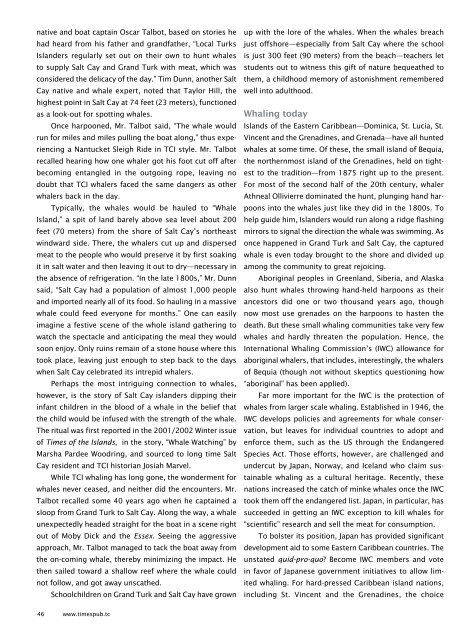Times of the Islands Summer 2019
Presents the "soul of the Turks & Caicos Islands" with in-depth features about local people, culture, history, environment, businesses, resorts, restaurants and activities.
Presents the "soul of the Turks & Caicos Islands" with in-depth features about local people, culture, history, environment, businesses, resorts, restaurants and activities.
Create successful ePaper yourself
Turn your PDF publications into a flip-book with our unique Google optimized e-Paper software.
native and boat captain Oscar Talbot, based on stories he<br />
had heard from his fa<strong>the</strong>r and grandfa<strong>the</strong>r, “Local Turks<br />
Islanders regularly set out on <strong>the</strong>ir own to hunt whales<br />
to supply Salt Cay and Grand Turk with meat, which was<br />
considered <strong>the</strong> delicacy <strong>of</strong> <strong>the</strong> day.” Tim Dunn, ano<strong>the</strong>r Salt<br />
Cay native and whale expert, noted that Taylor Hill, <strong>the</strong><br />
highest point in Salt Cay at 74 feet (23 meters), functioned<br />
as a look-out for spotting whales.<br />
Once harpooned, Mr. Talbot said, “The whale would<br />
run for miles and miles pulling <strong>the</strong> boat along,” thus experiencing<br />
a Nantucket Sleigh Ride in TCI style. Mr. Talbot<br />
recalled hearing how one whaler got his foot cut <strong>of</strong>f after<br />
becoming entangled in <strong>the</strong> outgoing rope, leaving no<br />
doubt that TCI whalers faced <strong>the</strong> same dangers as o<strong>the</strong>r<br />
whalers back in <strong>the</strong> day.<br />
Typically, <strong>the</strong> whales would be hauled to “Whale<br />
Island,” a spit <strong>of</strong> land barely above sea level about 200<br />
feet (70 meters) from <strong>the</strong> shore <strong>of</strong> Salt Cay’s nor<strong>the</strong>ast<br />
windward side. There, <strong>the</strong> whalers cut up and dispersed<br />
meat to <strong>the</strong> people who would preserve it by first soaking<br />
it in salt water and <strong>the</strong>n leaving it out to dry—necessary in<br />
<strong>the</strong> absence <strong>of</strong> refrigeration. “In <strong>the</strong> late 1800s,” Mr. Dunn<br />
said, “Salt Cay had a population <strong>of</strong> almost 1,000 people<br />
and imported nearly all <strong>of</strong> its food. So hauling in a massive<br />
whale could feed everyone for months.” One can easily<br />
imagine a festive scene <strong>of</strong> <strong>the</strong> whole island ga<strong>the</strong>ring to<br />
watch <strong>the</strong> spectacle and anticipating <strong>the</strong> meal <strong>the</strong>y would<br />
soon enjoy. Only ruins remain <strong>of</strong> a stone house where this<br />
took place, leaving just enough to step back to <strong>the</strong> days<br />
when Salt Cay celebrated its intrepid whalers.<br />
Perhaps <strong>the</strong> most intriguing connection to whales,<br />
however, is <strong>the</strong> story <strong>of</strong> Salt Cay islanders dipping <strong>the</strong>ir<br />
infant children in <strong>the</strong> blood <strong>of</strong> a whale in <strong>the</strong> belief that<br />
<strong>the</strong> child would be infused with <strong>the</strong> strength <strong>of</strong> <strong>the</strong> whale.<br />
The ritual was first reported in <strong>the</strong> 2001/2002 Winter issue<br />
<strong>of</strong> <strong>Times</strong> <strong>of</strong> <strong>the</strong> <strong>Islands</strong>, in <strong>the</strong> story, “Whale Watching” by<br />
Marsha Pardee Woodring, and sourced to long time Salt<br />
Cay resident and TCI historian Josiah Marvel.<br />
While TCI whaling has long gone, <strong>the</strong> wonderment for<br />
whales never ceased, and nei<strong>the</strong>r did <strong>the</strong> encounters. Mr.<br />
Talbot recalled some 40 years ago when he captained a<br />
sloop from Grand Turk to Salt Cay. Along <strong>the</strong> way, a whale<br />
unexpectedly headed straight for <strong>the</strong> boat in a scene right<br />
out <strong>of</strong> Moby Dick and <strong>the</strong> Essex. Seeing <strong>the</strong> aggressive<br />
approach, Mr. Talbot managed to tack <strong>the</strong> boat away from<br />
<strong>the</strong> on-coming whale, <strong>the</strong>reby minimizing <strong>the</strong> impact. He<br />
<strong>the</strong>n sailed toward a shallow reef where <strong>the</strong> whale could<br />
not follow, and got away unsca<strong>the</strong>d.<br />
Schoolchildren on Grand Turk and Salt Cay have grown<br />
up with <strong>the</strong> lore <strong>of</strong> <strong>the</strong> whales. When <strong>the</strong> whales breach<br />
just <strong>of</strong>fshore—especially from Salt Cay where <strong>the</strong> school<br />
is just 300 feet (90 meters) from <strong>the</strong> beach—teachers let<br />
students out to witness this gift <strong>of</strong> nature bequea<strong>the</strong>d to<br />
<strong>the</strong>m, a childhood memory <strong>of</strong> astonishment remembered<br />
well into adulthood.<br />
Whaling today<br />
<strong>Islands</strong> <strong>of</strong> <strong>the</strong> Eastern Caribbean—Dominica, St. Lucia, St.<br />
Vincent and <strong>the</strong> Grenadines, and Grenada—have all hunted<br />
whales at some time. Of <strong>the</strong>se, <strong>the</strong> small island <strong>of</strong> Bequia,<br />
<strong>the</strong> nor<strong>the</strong>rnmost island <strong>of</strong> <strong>the</strong> Grenadines, held on tightest<br />
to <strong>the</strong> tradition—from 1875 right up to <strong>the</strong> present.<br />
For most <strong>of</strong> <strong>the</strong> second half <strong>of</strong> <strong>the</strong> 20th century, whaler<br />
Athneal Ollivierre dominated <strong>the</strong> hunt, plunging hand harpoons<br />
into <strong>the</strong> whales just like <strong>the</strong>y did in <strong>the</strong> 1800s. To<br />
help guide him, Islanders would run along a ridge flashing<br />
mirrors to signal <strong>the</strong> direction <strong>the</strong> whale was swimming. As<br />
once happened in Grand Turk and Salt Cay, <strong>the</strong> captured<br />
whale is even today brought to <strong>the</strong> shore and divided up<br />
among <strong>the</strong> community to great rejoicing.<br />
Aboriginal peoples in Greenland, Siberia, and Alaska<br />
also hunt whales throwing hand-held harpoons as <strong>the</strong>ir<br />
ancestors did one or two thousand years ago, though<br />
now most use grenades on <strong>the</strong> harpoons to hasten <strong>the</strong><br />
death. But <strong>the</strong>se small whaling communities take very few<br />
whales and hardly threaten <strong>the</strong> population. Hence, <strong>the</strong><br />
International Whaling Commission’s (IWC) allowance for<br />
aboriginal whalers, that includes, interestingly, <strong>the</strong> whalers<br />
<strong>of</strong> Bequia (though not without skeptics questioning how<br />
“aboriginal” has been applied).<br />
Far more important for <strong>the</strong> IWC is <strong>the</strong> protection <strong>of</strong><br />
whales from larger scale whaling. Established in 1946, <strong>the</strong><br />
IWC develops policies and agreements for whale conservation,<br />
but leaves for individual countries to adopt and<br />
enforce <strong>the</strong>m, such as <strong>the</strong> US through <strong>the</strong> Endangered<br />
Species Act. Those efforts, however, are challenged and<br />
undercut by Japan, Norway, and Iceland who claim sustainable<br />
whaling as a cultural heritage. Recently, <strong>the</strong>se<br />
nations increased <strong>the</strong> catch <strong>of</strong> minke whales once <strong>the</strong> IWC<br />
took <strong>the</strong>m <strong>of</strong>f <strong>the</strong> endangered list. Japan, in particular, has<br />
succeeded in getting an IWC exception to kill whales for<br />
“scientific” research and sell <strong>the</strong> meat for consumption.<br />
To bolster its position, Japan has provided significant<br />
development aid to some Eastern Caribbean countries. The<br />
unstated quid-pro-quo? Become IWC members and vote<br />
in favor <strong>of</strong> Japanese government initiatives to allow limited<br />
whaling. For hard-pressed Caribbean island nations,<br />
including St. Vincent and <strong>the</strong> Grenadines, <strong>the</strong> choice<br />
46 www.timespub.tc

















